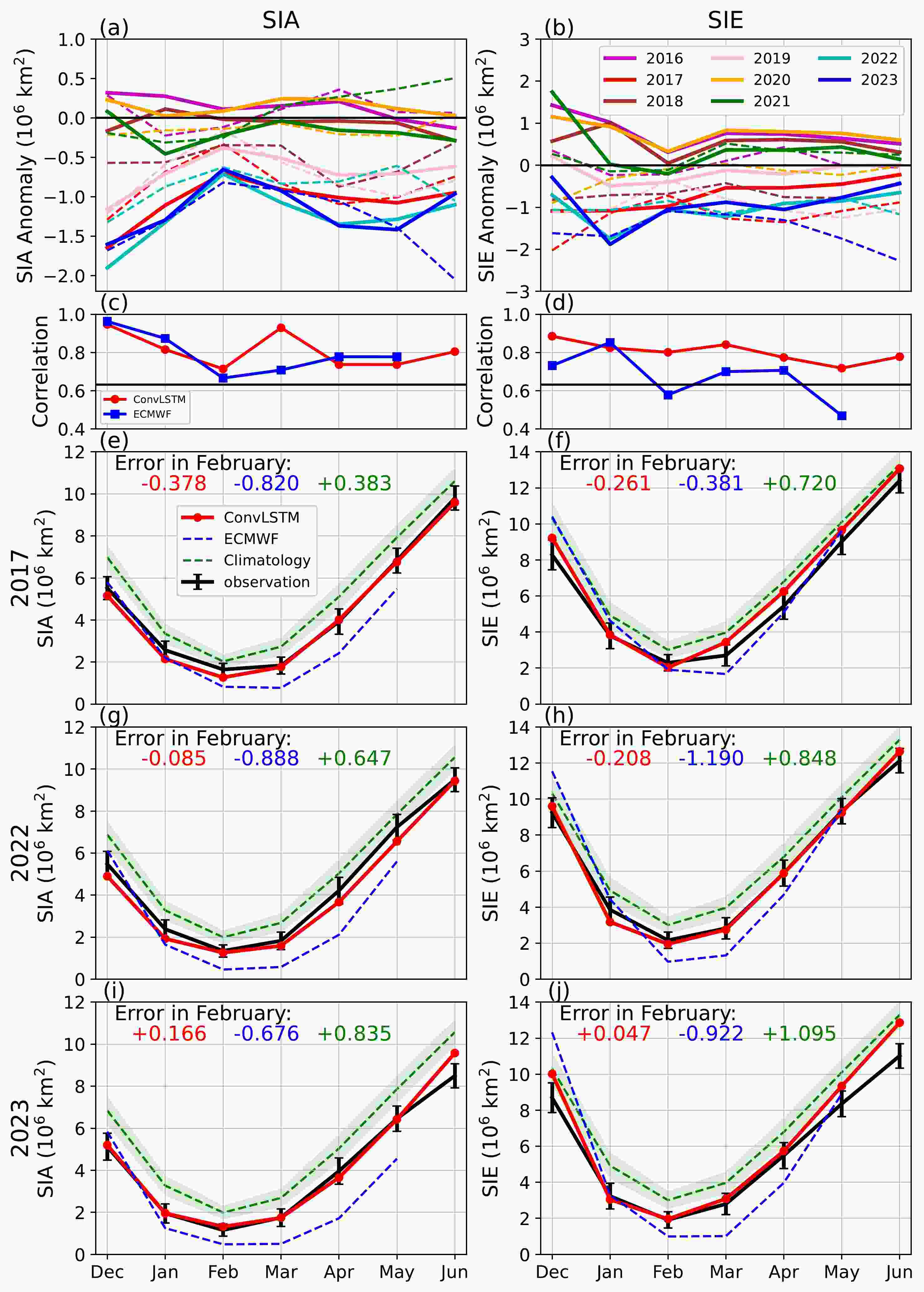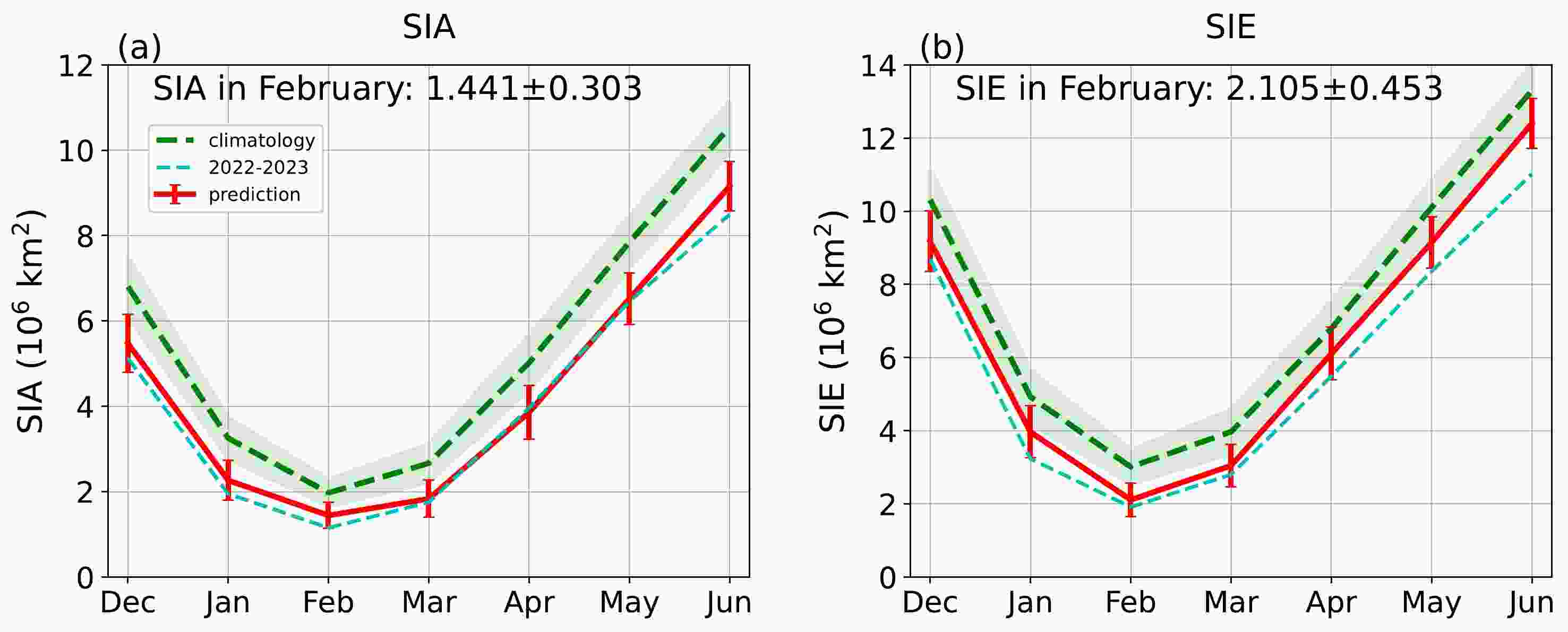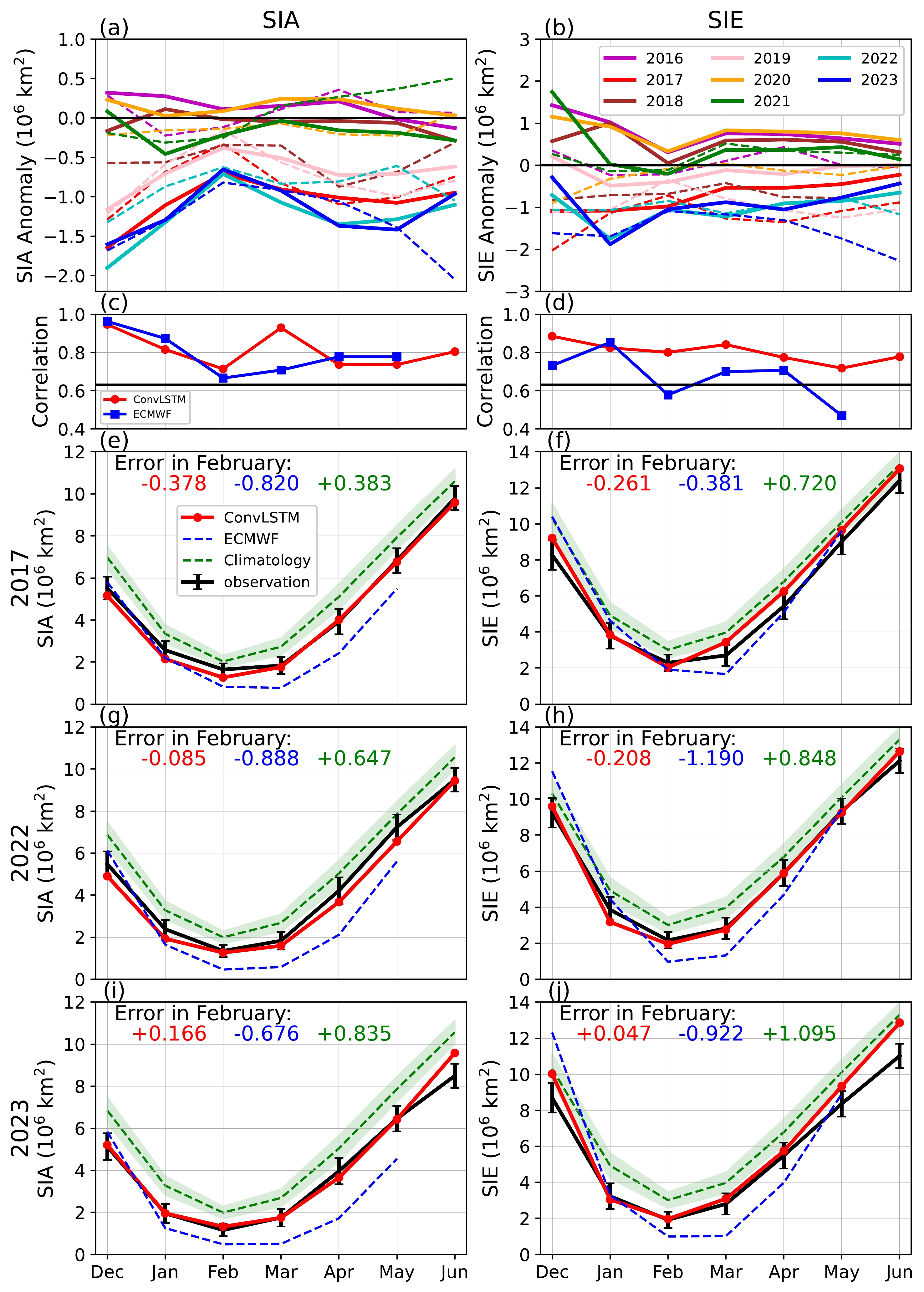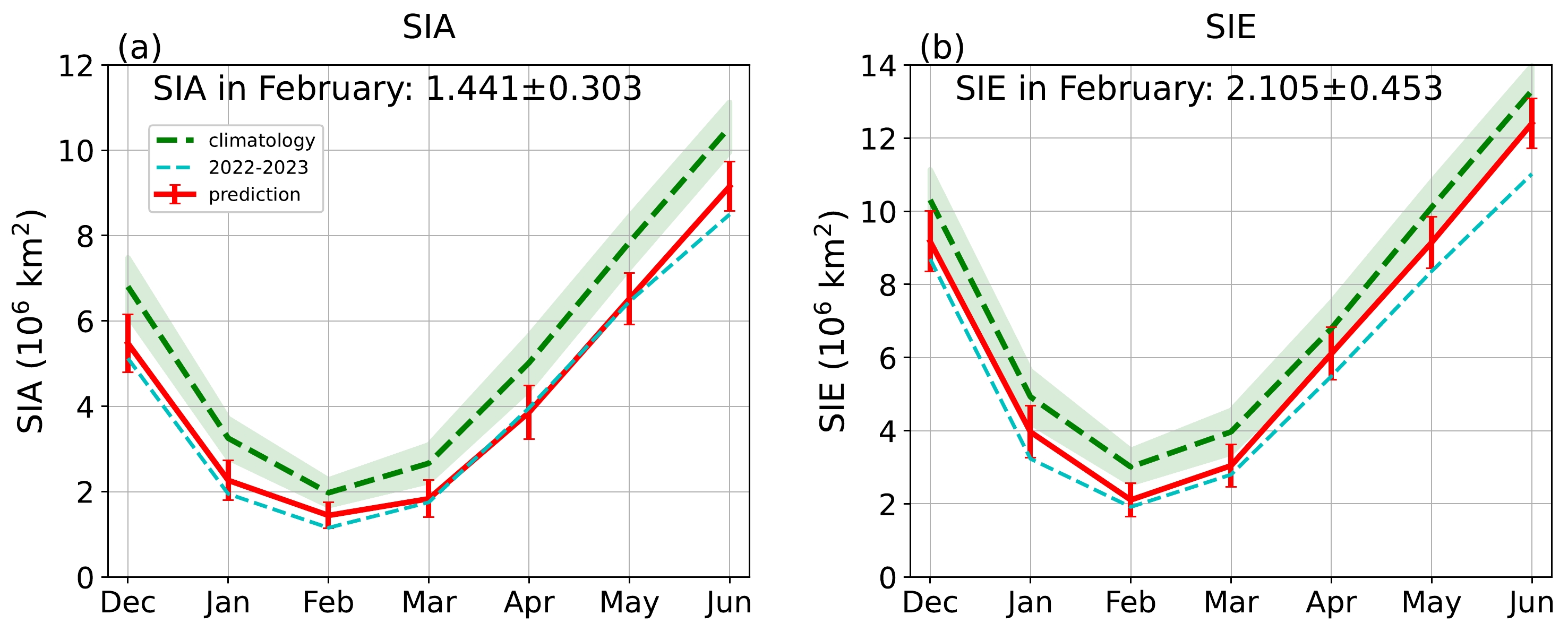-
The Antarctic sea-ice extent set a new record minimum (1.788 million km2) on 21 February 2023, being 36.7% lower than its climatology since the late 1970s (Liu et al., 2023). More importantly, this is the third record-breaking year in seven years, following 2017 and 2022 (Parkinson, 2019; Wang et al., 2022), demonstrating that the Antarctic sea ice is likely to reach a new state (Purich and Doddridge, 2023). It also raises concerns that, associated with anomalously low Antarctic summer sea ice, the atmosphere and ocean would be warmer in the context of the ice-albedo feedback (Goosse et al., 2018; Shokr and Ye, 2023), favoring warm water intrusion into the ice shelves and decreasing their stability (Cai et al., 2023). Additionally, the extremely low summer ice extent would have a profound influence on ice-associated organisms (Fretwell et al., 2023). Therefore, advanced predictions of Antarctic summer sea-ice extent are increasingly in demand (Massonnet et al., 2023), not only for climate research, but also for the practical needs of exploring the Antarctic (Chen and Yuan, 2004).
However, the prediction of Antarctic sea ice on the seasonal timescale has been a long-standing challenge (Jung et al., 2016). Currently, coupled dynamical models are the primary tool used for sea-ice forecasting in polar regions. However, state-of-the-art dynamical models exhibit low skill in predicting the Antarctic sea ice seasonally (especially in austral summer), possibly because of constraining factors such as the initializations, parameterizations, and incomplete observations employed (Bushuk et al., 2021; Libera et al., 2022; Payne et al., 2023). Recently, deep learning (DL) models have been developing rapidly as a powerful technique to capture the highly nonlinear relationship between features (i.e., predictors) and labels (i.e., predictands) using deep neural networks (Schmidhuber, 2015). The DL method has been successfully applied to sea-ice predictions in both the Arctic and Antarctic (Andersson et al., 2021; Liu et al., 2021; Ren et al., 2022; Ren and Li, 2023; Wang et al., 2023). For instance, Andersson et al. (2021) employed U-Nets to predict the Arctic sea ice over a six-month lead time, with results outperforming the European Centre for Medium-Range Weather Forecasts (ECMWF). However, there is not yet any precedent of using DL methods for seasonal-scale Antarctic sea-ice prediction.
Therefore, the motivation behind this study was to make an initial attempt at seasonal predictions of Antarctic sea ice using the DL approach, and to compare them with dynamical seasonal forecast systems. Notably, this study also responds to the latest call made by the Sea Ice Prediction Network-South (SIPN-South; Massonnet et al., 2023), which requires monthly Antarctic mean sea-ice area (SIA) forecasts extending at least six months into the subsequent year. Accordingly, the prediction results spanning from December 2023 to June 2024 are presented.
-
The DL method used here is the Convolutional Long Short-Term Memory (ConvLSTM) Network (Shi et al., 2015), which is a neural network that combines the advantages of a Convolutional Neural Network (Lecun et al., 1998) and Long Short-Term Memory (LSTM) network (Hochreiter and Schmidhuber, 1997). By integrating convolutional cells into LSTM cells, ConvLSTM can effectively extract both spatial and temporal information. The spatiotemporal correlation modeling enables ConvLSTM to better utilize the temporal and spatial information in the data, generalize more easily on small datasets, and have the capability to reduce overfitting. This makes it a powerful tool for solving complex 3D spatiotemporal sequence prediction problems (Shi et al., 2015; Xiong et al., 2021).
The Antarctic sea-ice concentration (SIC) observations are NSIDC-0051 (DiGirolamo et al., 2022) and NSIDC-0081 (Meier et al., 2021), covering the period from 1 January 1979 to 30 November 2023. Six variables were selected as predictors, including (1) SIC, (2) climatological SIC, (3) standard deviation of SIC, (4) sine and (5) cosine of the yearly time index, and (6) a gridded land mask (0 for land, 1 for ocean), and the predicted SIC was set as the predictand. The model aims to capture the spatiotemporal relationship based on a 12-month features to 12-month labels sequence, where the labels lag behind the features by one month and have an 11-month overlap. To validate the model, we conducted eight-year reforecast experiments from December–June 2015/16 to 2022/23. We trained the ConvLSTM model over eight rounds that targeted each reforecast, using the observational data before the corresponding start point, from the perspective of operational forecasts. In the application of prediction, the 12-month data before the start month were utilized to initialize the model and iteratively obtain predicted data up to June in the subsequent year. Among the reforecasts of eight years, we specifically selected three years (2017, 2022, 2023) when the February SIE reached record lows for further comparison (last three rows of Fig. 1). Additionally, we have included the results of the ensemble mean of the ECMWF from the Copernicus Climate Change Service (C3S) Prediction project (Thepaut et al., 2018). ECMWF shows the best sea-ice prediction skill in subseasonal-to-seasonal prediction among the dynamical models (Zampieri et al., 2019). Therefore, we acknowledge its potential for seasonal prediction, even though a rigorous evaluation is yet to be conducted.

Figure 1. Monthly Antarctic (a) SIA and (b) SIE anomaly (units: 106 km2) time series from NSIDC-0051/0081 (dash lines) and predictions of ConvLSTM (solid lines) from December–June 2015/16 to 2022/23. The anomalies were calculated relative to the 1979–2022 climatology. (c, d) The correlation coefficients between the eight-year observations and the predictions from ConvLSTM (red line) and ECMWF (blue line) of (c) SIA and (d) SIE, with a significance level of 0.05 (black line). (e, f) The predictions of ConvLSTM (red solid line), ensemble mean of ECMWF (blue dashed line), climatological benchmark (green dashed line) with a range of one standard deviation (green shading), and the observations (black solid line) with a range of one standard deviation (error bars), of (e) SIA and (f) SIE from December 2016 to June 2017. The errors in February are marked in the figures with the corresponding colors (units: 106 km2). Panels (g, h) and (i, j) are the same as (e, f) but for December–June 2021/22 and 2022/23, respectively.
As illustrated in Figs. 1a and b, ConvLSTM successfully captures the interannual variability of sea ice. The predicted results (solid lines) are in good agreement with observations (dashed lines) for most months, and capture the observed interannual variability. Notably, during the three years with summer record SIE lows, the ConvLSTM predictions were considerably lower compared to the other years (indicated by the red, cyan, and blue lines in Figs. 1a and b). Furthermore, the correlation coefficients between the ConvLSTM predictions and observations of SIA and SIE are both statistically significant at the 0.05 significance level (Figs. 1c and d). The correlation coefficients of ECMWF are comparable with ConvLSTM for SIA, but are lower than ConvLSTM for SIE. The correlation coefficients of the two methods both suggest that the prediction skill is relatively low in February, which could potentially be attributed to the predictability of Antarctic sea ice (Holland et al., 2013).
ConvLSTM also successfully captures the interseasonal variability of sea ice in austral summer and autumn, evident by comparing the three years with summer record SIE lows (Figs. 1e–j). The ConvLSTM-predicted phases of SIA and SIE correspond with observations, reaching their minimums in February. By contrast, for the ECMWF predictions, most of the minimums occur in March and have belated growth. Furthermore, the SIA and SIE results of the ECMWF predictions are significantly lower than observed during late summer and early autumn, falling outside the range of two standard deviations. These results imply that there is still significant room for the development of dynamical models. In contrast, the prediction results of ConvLSTM mostly fall within the range of one standard deviation of the observations, demonstrating its reliability and robustness.
The predictions for SIA and SIE starting in December 2023 are shown in Fig. 2. According to the ConvLSTM model, the predicted SIA and SIE for February 2024 are 1.441 ± 0.303 million km2 and 2.105 ± 0.453 million km2, respectively. These values slightly exceed the observed values in 2023. Overall, the projected values for the summer and autumn of 2024 are significantly below the climatological average, by one to two standard deviations. Consequently, the sea ice is predicted to remain low in 2024, but may not create a new record low.

Figure 2. ConvLSTM prediction (red line) with a range of one standard deviation (error bars) for monthly Antarctic (a) SIA and (b) SIE spanning from December 2023 to June 2024. The green dashed line and its shading represents the climatology with a range of one standard deviation calculated from 1979 to 2022. The cyan dashed line represents the observation spanning from December 2022 to June 2023. The predicted SIA and SIE values for February 2024 are marked in the figures with an uncertainty of one standard deviation (units: 106 km2).
-
The Antarctic sea ice is changing rapidly with climate change. Our reforecast experiment results from December–June 2015/16 to 2022/23 indicate that the DL model is effective at predicting the SIE and SIA in February, demonstrating better prediction skill compared to traditional dynamical models. The ConvLSTM model extracts information from the spatial patterns of SIC and makes reliable predictions by iteration, which demonstrates its advantage in capturing information on sea-ice spatiotemporal variability. The results here of an attempt at an eight-year Antarctic summer sea-ice reforecast using a DL approach indicate that DL is promising for tackling this issue of seasonal prediction. In general, DL has shown promise in Antarctic sea-ice prediction. By utilizing its powerful nonlinear data processing capabilities, it can help us establish more accurate and efficient models for predicting sea-ice evolution. With the advancement of technology and the accumulation of data, it is believed that DL will provide continually improving capability in the field of Antarctic sea-ice prediction, and contribute more to climate research and forecasting in the Antarctic.
Meanwhile, DL methods still face challenges in predicting Antarctic sea ice. One primary obstacle is the limited number of available training samples, which is a consequence of the relatively short history of satellite observations. Additionally, the performance of DL relies strongly on the quality of training data available, which is constrained by the relatively high uncertainty of the observations. We believe that DL will assume an increasingly important role in Antarctic sea-ice prediction with the development of observational technology and satellite data retrieval accuracy. Furthermore, the record low extent of Antarctic sea ice in winter 2023 denotes a potential shift towards a new state (Purich and Doddridge, 2023), which poses an ongoing challenge for capturing unprecedented sea-ice events using DL models.
Acknowledgements. This study was supported by the National Key R&D Program of China (Grant No. 2022YFE0106300), the National Natural Science Foundation of China (Grant Nos. 41941009 and 42006191), the China Postdoctoral Science Foundation (Grant No. 2023M741526), the Southern Marine Science and Engineering Guangdong Laboratory (Zhuhai) (Grant Nos. SML2022SP401 and SML2023SP207), and the Program of Marine Economy Development Special Fund under Department of Natural Resources of Guangdong Province (Grant No. GDNRC [2022]18). We acknowledge the National Snow & Ice Data Center (NSIDC) for producing and maintaining the SIC data.
Deep Learning Shows Promise for Seasonal Prediction of Antarctic Sea Ice in a Rapid Decline Scenario
- Manuscript received: 2023-12-24
- Manuscript revised: 2024-01-15
- Manuscript accepted: 2024-01-25
Abstract: The rapidly changing Antarctic sea ice has garnered significant interest. To enhance the prediction skill for sea ice and respond to the Sea Ice Prediction Network-South’s latest call, this study presents the reforecast results of Antarctic sea-ice area and extent from December to June of the coming year with a Convolutional Long Short-Term Memory (ConvLSTM) Network. The reforecast experiments demonstrate that ConvLSTM captures the interannual and interseasonal variability of Antarctic sea ice successfully, and performs better than the European Centre for Medium-Range Weather Forecasts. Based on this, we present the prediction from December 2023 to June 2024, indicating that the Antarctic sea ice will remain at lows, but may not create a new record low. This research highlights the promising application of deep learning in Antarctic sea-ice prediction.
-
Keywords:
- deep learning,
- Antarctic,
- sea ice,
- seasonal prediction




 DownLoad:
DownLoad:










 AAS Website
AAS Website 
 AAS WeChat
AAS WeChat 

